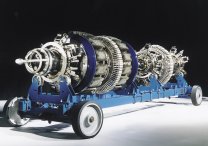Pipeline Pigs and Pigging Review
Fluid Flow Table of Contents
Hydraulic and Pneumatic Knowledge
Pipeline Pigs and Pigging Review
Pigging in the context of pipelines refers to the practice of using devices known as "pigs" to perform various maintenance operations on a pipeline. This is done without stopping the flow of the product in the pipeline.
These operations include but are not limited to cleaning and inspecting the pipeline. This is accomplished by inserting the pig into a 'pig launcher' (or 'launching station') - an oversized section in the pipeline, reducing to the normal diameter. The launcher / launching station is then closed and the pressure-driven flow of the product in the pipeline is used to push it along down the pipe until it reaches the receiving trap – the 'pig catcher' (or 'receiving station').
Pipeline pigs are devices that are used to perform a variety of pipeline (pipe) maintenance, cleaning and inspection operations. The term "Pigs" is derived from the noises many pipeline pigs create while performing their function within the pipline. Often these devices perform their various operations without stopping the flow of fluid. Pipelines that have mechanical obstructions, such as, valves, extreme pipe size transitions, complex turns or small radii changes in direction can prevent many pigging devices from performing their function.
The advantages of pipeline pigs is the economy which they perform their function. I is practical for a pipline pig to throughly clean or remove the contents of a pipline, inspect internal welds, or perfrom ultra sonic tests to determin ethe integrity of a pipeline. Many modern pigging devices are equiped with wireline devices or wireless device to transmit gps location, or other parameters while performing their function.
Pigging is a generic term used within industry to describe the maintenance of pipelines. Pigging technology has been used for many years to perform mantenance operations within large diameter pipeline systems. New technologies has allowed similar operations within smaller diameter pipeline systems.
 |
 |
Modern Pipeline Pigs |
|